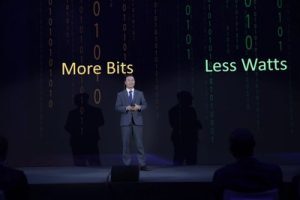
Water Conservation: 7 Simple Ways to Save Water at Home and in Your Business
Water is one of our most precious resources, yet it is often wasted without thought. ...

Huawei Carrier’s Chief Marketing Officer Dr. Philip Song presented five suggestions for green development in the ICT industry, topped by paying more attention to carbon emissions and reducing power consumption.
He said “First, we should vigorously develop the ICT industry to enable green development in other industries. Second, we must pay more attention to carbon emissions of ICT infrastructure during usage rather than just during manufacturing. Third, the systematic solution of “Green Site, Green Network, and Green Operation” will help carriers continuously improve network capacity and reduce power consumption per bit, achieving “More Bits, Less Watts”. Fourth, we must define a unified energy efficiency indicator system to identify the main problems of energy consumption. Fifth, watts are decided by user experience.”
He made the remarks during the Huawei Day 0 Forum which is held under the theme of “Lighting up the Future” as part of its lead up to MWC22 Barcelona.

For his part, Ryan Ding, Huawei’s Executive Director and President of the Carrier BG, said Green ICT is key to sustainable growth in the digital economy. The ICT industry is providing new technologies to help other industries reduce their carbon footprints. In fact, these savings are predicted to amount to ten times larger than the ICT industry’s own footprint.
At the forum, Ding also shared Huawei’s green strategy: More Bits, Less Watts. With its full range of green solutions, including green site, green network, and green operation, Huawei aims to help operators increase network capacity and cut the energy consumption per bit. Huawei also proposed the Network Carbon Intensity index to quantify the carbon emissions of the ICT industry and help operators make their green strategy a reality.
Ding said that operators can work on three factors: connection density, computing diversity, and carbon reduction intensity, and called on operators to join Huawei in its GUIDE business blueprint to create a better digital economy together.
The global digital economy is developing rapidly, and over 50% of global GDP will be digitalized in 2022. Many countries and regions, like China, South Korea, and the EU, have already announced huge investment plans for the digital economy. As ICT infrastructure providers, operators will play an increasingly important role in leading the development of the future digital economy.
During his keynote, Ding explained that the vitality of digital economy can be evaluated by three factors: connection density, computing diversity, and carbon reduction intensity, and that these factors give operators the levers they need to shape the future of the digital economy.
By increasing connection density, operators can grow their 5G user base and expand their business scope. By diversifying their computing resources, operators can create synergies between connectivity and IT to boost enterprise digitalization for new growth. In carbon reduction, new green ICT solutions, like those Huawei provides, will increase network capacity and cut the energy consumption per bit for greener development.
He noted that commercial 5G deployment started two years ago, and since then, the numbers of 5G networks, users, and devices have grown rapidly. By the end of 2021, more than 200 operators have deployed commercial 5G networks, servicing more than 700 million 5G users. There are currently over 1,200 commercial 5G devices in use. This growing user base is bringing commercial returns to operators while driving continuous network rollouts.
During the event, Ding shared 5G success stories from various operators and showed how new 5G applications like AR, VR, and new video are offering users new experiences. Flexible 5G pricing models are also benefiting both users and operators and driving rapid growth in the 5G user base.
In China, 5GtoB private networks have been deployed at scale in multiple industries. By the end of 2021, Huawei has signed more than 3,000 commercial 5GtoB contracts with Chinese operators and partners, gaining a wealth of experience in industry applications. One highlighted example was from China’s Inner Mongolia, where a coal mine is using 5G to remotely control shearers. Since 5G was deployed, coal miners have been working in a safer and more comfortable environment.
According to Ding, as more industries are going digital, IT infrastructure will need to be rebuilt to drive more efficient operations. By creating synergies between IT and CT, cloud and edge, and cloud and networks, Huawei hopes to help operators go digital and intelligent and achieve new revenue growth. In Asia Pacific, for example, Huawei’s OneStorage solution has helped one operator cut TCO by 30%.
اترك تعليقا